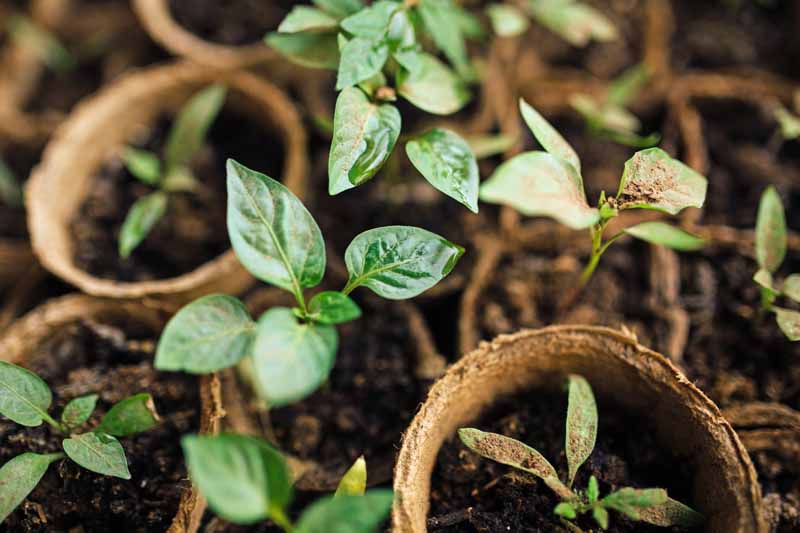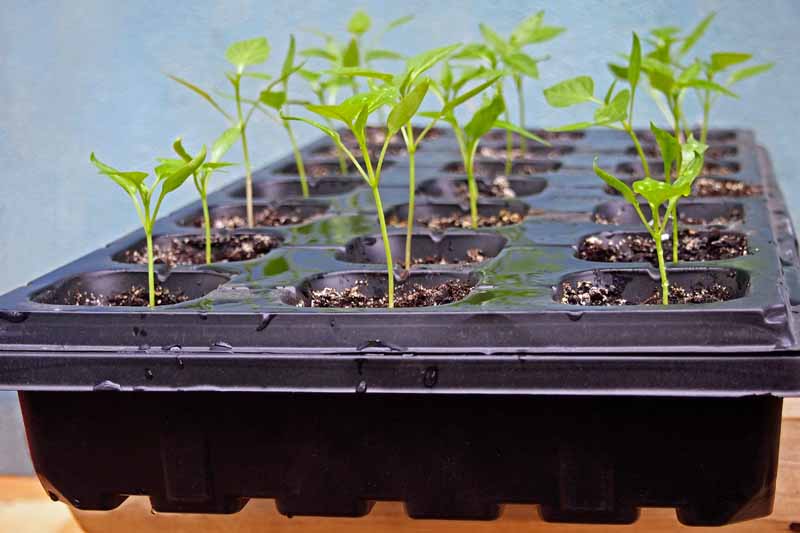More than just being a magical process to watch, it can also mean you get to play around with interesting varieties you might not find in your local garden center, and learn about your plants much more intimately than you would otherwise. But then! Tragedy strikes and your seedlings come down with a serious case of “damping off.” But what is damping off, you might ask? We link to vendors to help you find relevant products. If you buy from one of our links, we may earn a commission.
What is Damping Off?
“Damping off” is a soil-borne fungal disease that affects seedlings, causing the rotting of stem and root tissues at and below the soil surface of the young plants. The term is quite a general one, encompassing several disease-causing culprits, the most common of which are well-known fungal foes such as Rhizoctonia spp., Fusarium spp. and the water mold Pythium spp. This disease affects a wide variety of vegetables and flowers. Infected plants usually germinate successfully and come up fine, but start to show signs that all is not well a few days down the line. Young leaves, roots, and stems of newly emerged seedlings are all highly susceptible to infection. This disease causes such major issues in the root system of the plant that seedlings infected by damping off rarely survive to produce a vigorous plant. Even worse, it is usually a large section, or an entire tray of seedlings that is killed. In short, this fungal infection can really decimate your seedlings, and proper care needs to be taken to prevent a tragedy from occurring. The good news is that, although mature plants can still be affected by these pathogens, from the moment your plants have mature leaves and a well-developed root system, they are much more resistant the fungus or mold that causes damping off. There is therefore a critical period of growth between planting and maturity when special care needs to be taken to protect sensitive seedlings.
How to Identify Damping Off
The most common way damping off will present itself is when your plant stalks become water-soaked, thin and mushy, and fall over at the base and die. The seedlings, especially the cotyledons (the first leaves produced) may have a kind of gray-brown color, and young leaves will wilt and turn from green-gray to brown. It is also common to see a fluffy white cobweb growth on infected plants. When you pull your plants up, you can also see signs of the disease on their root systems. Roots on infected plants are either absent, stunted, or have grayish-brown sunken spots.
Prevention and Protection Measures
I’ll give you the bad news first: Once your plants catch a case of damping off, they’re done for. There is nothing we can do to cure this disease once it’s taken hold, and even if there was, the tiny seedlings die so quickly that there would be very little time to help even if you could. The good news is that, as damaging as it is, there are a few practical, actionable steps you can take to see off damping off before it becomes established. There are two P’s that you should keep in mind when it comes to damping off – prevention and protection.
Prevention Tips
Preventative tips include:
1. Use a sterile potting mix, rather than soil from your garden.
The fungi that cause this disease live in the soil, so preventing soil contact with your vulnerable seedlings is the first good place to start.
If this really isn’t possible for you, or if you plan to reuse soil mix, then you can also sterilize your soil. You can do this by baking it in the sun. But in my experience, I’ve found that it’s quicker and easier either to use either your oven or your microwave. Personally, I prefer doing it in the microwave, as heating in the oven can generate a funky smell. Just put your soil mix in a suitable container, cover it loosely, and heat on high for 8-10 minutes. It will get hotter than you might think, so be aware of this when you’re handling your soil mix afterwards. Heating up your soil in this way helps to kill any fungal foes lurking within.
2. Use clean pots.
Fungal spores are tiny and can reside in even the smallest amount of soil residue left in pots. It’s best to sterilize your pots before using them, using a mixture of one part bleach to 10 parts water.
3. Help your seeds as much as you can.
Anything you can do to minimize your plants’ struggle helps to maximize their strength. This includes planting them at the right depth, so they don’t have to work so hard to germinate, getting your soil substrate mix right, and choosing a sunny, warm spot for them to thrive in.
4. Don’t overcrowd your seedlings.
This isn’t because your seedlings don’t like company, but because ensuring room for good air circulation is key to preventing fungal disease from gaining a foothold.
Going one step further, this could even include using a fan to help circulate air around your baby plants.
5. Water from the bottom up.
Watering from the bottom up means that the seeding itself stays dry, and is therefore more protected. You could also add some surface sand or gravel around your seedlings to help keep them high and dry. Continuing with the irrigation theme, it’s also important not to over-water plant starts. Learn more about this method in our guide.
6. Remove any suspect plants immediately.
I’m the first to become emotionally attached to my baby plants, and I am absolutely loathe to kill any of them. But it’s better to be ruthless here. The moment you suspect one plant might be showing signs of damping off, it’s best to get him out of there to stop him from infecting his neighbors. Better safe than sorry!
Protection Tips
In my experience, conventional fungicides aren’t really worth trying. But I have had luck with a few of these homemade protective concoctions. To be clear, they are only useful to protect against – not to cure – this disease. But they can give you that little edge that might make all the difference.
A strong brew of chamomile or cinnamon tea isn’t just a nice nightcap for us. You can also use it to water and/or mist your seedlings. Mix in a splash of hydrogen peroxide per quart of water and mist seedlings with it. Apply a light dusting of cinnamon to the soil surface. I’ve found this to be especially effective! Applications of compost tea may also help, as it is full of beneficial bacteria and fungi that out-compete many bad pathogens.
Remember Your P’s!
And here I don’t mean please! Protection and prevention are the name of the game in beating damping off. By following all the tips above, you stand a fair chance of avoiding and even overcoming this disease. If you loved this article, be sure to check out these as well:
Integrated Pest Management : What It Is and How to Use It The Benefits of Using Soil Inoculants and Microbes in the Garden How to Start Worm Farming: Adventures in Composting and Vermiculture
© Ask the Experts, LLC. ALL RIGHTS RESERVED. See our TOS for more details. Uncredited photos: Shutterstock.



